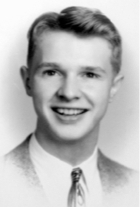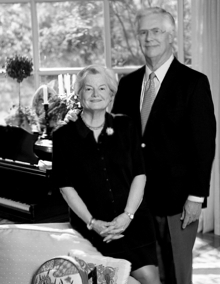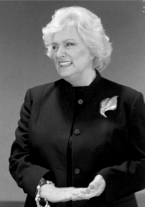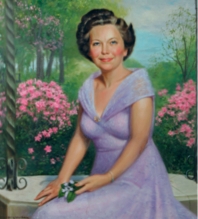Who are these people?

Rudolph A. Light Hall—Rudolph A. Light, M.D., was a graduate of the School of Medicine, a professor of Surgery, director of the surgical research laboratory, and a member of the Board of Trust.
L. C. Langford Auditorium—Lilburn Langford was a Clarksville native who developed a chain of restaurants and soda fountains, some operated under his name and some within department stores and drug stores. He is credited with inventing the chocolate malted milk shake. After his death, his widow contributed a substantial portion of the funding for the auditorium’s construction, which was completed in 1977.
Kim Dayani Human Performance Center—Dr. Kioomars (Kim) Dayani, M.D., was a native of Iran who came to the U.S. to pursue his education and who graduated from the School of Medicine in 1965. He founded a health care company in Kansas City, and, following his death in 1981, his widow contributed substantively to the contruction of the health promotion facility that bears his name.

Vanderbilt Bill Wilkerson Center for Otolaryngology and Communication Sciences—The Bill Wilkerson Clinic joined hands with Vanderbilt’s Department of Otolaryngology to form the Vanderbilt Bill Wilkerson Center as an integral part of VUMC in 1997. The Wilkerson Center traces its roots to the 1940s, when it was founded by a prominent local physician Wesley Wilkerson, M.D., Bill Wilkerson was the doctor’s son who was killed in World War II at the age of 19.

Ann and Roscoe R. Robinson Medical Research Building—Roscoe R. “Ike” Robinson, M.D., was vice chancellor for Health Affairs at Vanderbilt from 1981 to 1997, and it was during his tenure that this building, originally known as the Medical Research Building, was built. The building was named for Robinson and his wife Ann in 2000.

Frances Williams Preston Building—Frances Williams Preston is the Nashville native who was CEO of the music licensing business Broadcast Music Inc. (BMI). Because of her longstanding interest in cancer research and her involvement with the T.J. Martell Foundation for Leukemia, Cancer, and AIDS Research, the building, which opened in 1993 as Medical Research Building II, was named in her honor in 2000. Preston’s name is also on the Frances Williams Preston Laboratories, which were founded in 1993 with funding from the T.J. Martell Foundation for Cancer, Leukemia, and AIDS Research.
Vanderbilt-Ingram Cancer Center—A 1999 gift from the Ingram Charitable Fund established the E. Bronson Ingram Cancer Center at Vanderbilt University. E. Bronson Ingram was a longtime member of the Vanderbilt Board of Trust and chairman of the board. He died of cancer in 1995. Bronson Ingram’s widow, Martha, was chair of the Board of Trust and his son Orrin is on the Board.
Henry-Joyce Cancer Clinic—Kathryn Craig Henry contributed the funds to establish this treatment center for people with cancer. It was dedicated in 1988 and named in memory of Cornelius Abernathy Craig, her father; Douglas Selph Henry, her husband; and Harry Alexis Jones Joyce, who was the first husband of Mrs. Henry’s daughter, Peggy Henry Joyce Wood.
Annette and Irwin Eskind Biomedical Library—The Eskind Library, dedicated in 1994, is named for Irwin B. Eskind, M.D., who was a clinical professor of Medicine and his wife Annette. Eskind was an alumnus of the medical school, a member of the Vanderbilt Board of Trust, a member of the Medical Center Board, and president of the Canby Robinson Society. Annette Eskind has been active in many community causes, is founder of the Metropolitan Nashville Public Education Foundation and in 2008 received the Vanderbilt Medical Alumni Association’s Distinguished Service Award.
Vanderbilt Stallworth Rehabilitation Hospital—This hospital, a joint venture between Vanderbilt and HealthSouth, opened in 1993. Its construction was supported in part by a contribution from the estates of Hugh W. Stallworth and his wife Anita Bevill McMichael Stallworth.
Monroe Carell Jr. Children’s Hospital at Vanderbilt—Monroe Carell Jr. was chairman of Central Parking Corporation, past chairman of the Children’s Hospital board of directors, and the chairman for the Campaign for Children’s Hospital. He was also on the University Board of Trust and the Medical Center Board. He and his wife Ann made a substantial contribution toward the construction of the new freestanding Vanderbilt Children’s Hospital in 1999.

Mary Ragland Godchaux Hall—Godchaux Hall is the 1925 School of Nursing building. Starting in 1934, it was known as Mary Kirkland Hall, named for the wife of Chancellor James Kirkland. In 1958 the building was renamed Mary Henderson Hall, after Mary Kirkland’s maiden name, because of the longstanding confusion resulting from having two buildings on campus named “Kirkland Hall.” Then, in 1971, following a renovation that converted the dorm space in the building to other uses, the structure was again renamed, this time after Mary Ragland Godchaux. Mrs. Godchaux was the wife of Frank A. Godchaux Jr., whose family had helped fund the late ‘60s-early ‘70s remodeling of the building.
Patricia Champion Frist Hall—This 1998 addition to the School of Nursing is named for Mrs. Frist, who is a graduate of Vanderbilt, as is her husband Thomas Frist Jr. M.D., The building was made possible by a $2 million gift by the couple.
Vanderbilt Page-Campbell Heart Institute—This institute was anchored by Vanderbilt’s partnership with Nashville’s renowned Page-Campbell Cardiology Group, which in turn was named after its founders, Harry Page Jr. M.D., and Dr. W. Barton Campbell, M.D.
Selected Other Named Areas within VUMC
A.B. Hancock Laboratory—Located in the Preston Building, the lab is named for A.B. “Bull” Hancock, famed horse breeder of the legendary Claiborne Farm in Paris, Ky. The laboratory was established in 1972 in his memory and honor by his widow, Waddell Hancock, and a group of friends after his death. The lab’s work focuses on prevention and early detection of cancer.
Elizabeth B. Lamb Center for Pediatric Research—This center, housed on the sixth floor of Medical Center North, was established in 1990 by George and Elizabeth “Pat” Lamb. George Lamb, who died in 2001, was a chairman of United Parcel Service. Three of the Lambs’ four children attended Vanderbilt. The Lamb Center focuses on virology research and scientific training.
The Joe and Howard Werthan Building—This addition to Medical Center North on the 21st Ave. South side opened in 1972. At the time the VUMC office of News and Public Affairs noted in a press release: “The building was named in memory of father-and-son members of a distinguished Nashville family. Joe Werthan, the father, at the the time of his death in 1967, was honorary chairman of Werthan Industries. His son, Howard M. Werthan, who died earlier the same year, was vice president and secretary of the company.”
Zerfoss Student Health Center—This facility, at the back of Medical Center North, opened in 1967. It was named in honor of Thomas B. Zerfoss M.D., who was a University physician from 1926 to 1962, and was the first and longtime head of Student Health.
Galloway Building—On the south end of Medical Center North, visible from the area around the awning entrance to the building, carved in marble, are the words “Galloway Building.” When VUMC decided to relocate from downtown Nashville to its present site in 1925, the Galloway name came along. Nashville-area Methodist churches had funded the construction of a hospital at the downtown site that was to partner with the School of Medicine. Construction began, but money ran low, and, after an internal dispute about whether it would be better to see through the construction downtown or seek new money and start over on 21st Avenue South, the decision was made to move VUMC to the main campus. There were hurt feelings among many Nashville Methodists, who had given money for the downtown hospital’s construction, so, as a goodwill gesture, a wing of the new VUMC building was christened the Galloway Building. Oh, and who was Galloway? A Methodist Bishop.
A.B. Learned Laboratory—Andrew Brown Learned graduated from Vanderbilt in 1889 with a B.E. degree and was a lumber manufacturer in Natchez, Miss. He was a regular contributor to Vanderbilt and in 1953 he gave a donation to the University toward construction of the laboratory addition to VUMC.
Elliot V. Newman Center for Clinical Research—Elliot Newman M.D.,was a cardiologist, scientist, and teacher who was a pioneer in the development of medical engineering and the use of applied mathematics and computer science to medical research. His interest in applying science for the benefit of patients led to his receiving grants from the U.S. Public Health Service, and led, in 1960, to the establishment of the federally funded Clinical Research Center which bears his name.

Leave a Response